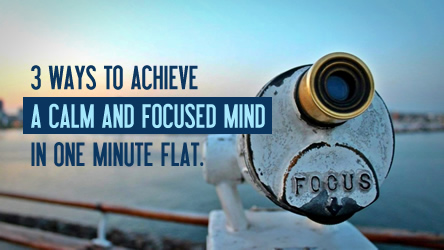I was recently asked to contribute to an article commissioned by Bupa Life Insurance on ways in which to achieve a calmer life. I submitted the suggestions outlined below, but you can read the entire article, including tips from a number of other ‘expert advisors’ on the Bupa website:
My guess it that you’ve probably been told to chill out or stay calm at some point in your life. Perhaps even more than once!
But were you ever taught how to do that? Being told to stay calm can be infuriating, but knowing how to stay calm, or to find calm in challenging situations, is a useful skill, and once you know how, it’s not difficult — and you don’t need special circumstances or a lot of time.
In fact, there are hundreds of ways to find balance. We’ll try out three simple methods: one in which you relax your body, one in which you connect with the environment around and within, and a third in which you use your capacity to think in creative ways.
Breathe as though you were sound asleep.
Specifically, take twelve breaths.
Make each subsequent breath a fraction softer, slower, quieter and less effortful, so that your last breath is so subtle you can hardly tell whether you are breathing or not.
For even deeper relaxation, with each out-breath identify and release any tension you notice in the eyes, face, jaw and neck.
Look, listen and feel.
This technique has three simple steps.
- Notice five shapes, colours, or textures you can see.
Don’t rush. Take the time to really appreciate the richness of your visual experience. - Now close your eyes and listen out for five distinct sounds.
You might like to identify the most obvious and the most subtle, the closest and the most distant, or just variations in pitch, volume and tone. - Finally, identify five different sensations within your body.
You could note the texture of your clothing on your skin, the contact made between your upper and lower lip, an ache or pain, some tension around the eyes or jaw, a sense of fatigue or temperature differentials between various parts of the body.
If you have time you could continue this three step process another four times, focusing on four, then three, then two and finally just one object for each of the three senses. By the end, you will likely feel a whole lot calmer.
Contemplate a positive quality.
Think of some quality missing from your life at present. Perhaps playfulness, delight, gratitude, wonder, warmth or tenderness. See if you can remember a time when this quality was present in your life.
Alternatively, see if you can recall something positive from your day. It could be as simple as a good cup of coffee, a kind word from a colleague, a moment of rest, or something nice you did for a friend.
Whatever the quality or memory, bring it to mind. Notice how it makes you feel. Bask in the sensations, as though you were soaking them up, being infused with the qualities of that experience.
What next?
These are just a few of the many meditation and mindfulness techniques you can use to find and retain balance. On our Meditation & Mindfulness for Beginners Course you’ll learn a range of techniques that you can adapt to your own needs and use as a tool to combat the stresses and anxieties of life. Meditation practiced this way is surprisingly easy and enjoyable, and by learning how to stay calm, you can then apply your focus where it is needed the most,. This allows you to identify your fears and worries and to approach them in a more orderly way. In doing so, you will be able to calm your mind and manage strong emotions more easily, making you feel more capable, productive and content.

